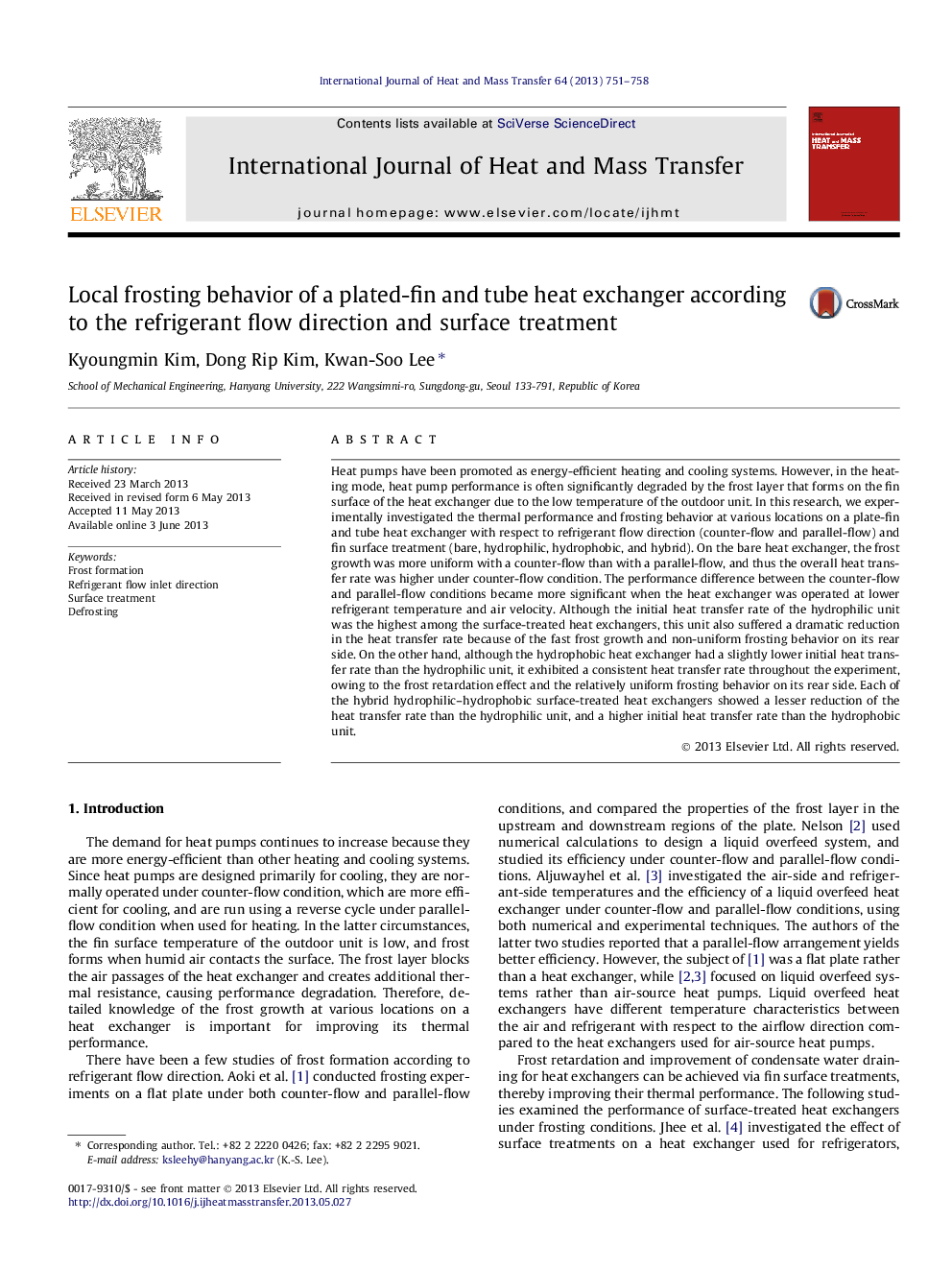| کد مقاله | کد نشریه | سال انتشار | مقاله انگلیسی | نسخه تمام متن |
|---|---|---|---|---|
| 7058858 | 1458078 | 2013 | 8 صفحه PDF | دانلود رایگان |
عنوان انگلیسی مقاله ISI
Local frosting behavior of a plated-fin and tube heat exchanger according to the refrigerant flow direction and surface treatment
ترجمه فارسی عنوان
رفتار گرم شدن محلی یک مبدل حرارتی گالوانیزه و با توجه به جهت جریان مبرد و درمان سطح
دانلود مقاله + سفارش ترجمه
دانلود مقاله ISI انگلیسی
رایگان برای ایرانیان
کلمات کلیدی
شکل گیری یخبندان، جهت ورودی جریان مبرد، درمان سطحی، خنثی کردن،
ترجمه چکیده
پمپ های حرارتی به عنوان سیستم های گرمایشی و خنک کننده انرژی مورد استفاده قرار می گیرند. با این حال، در حالت گرما، عملکرد پمپ گرما اغلب به طور قابل ملاحظه ای توسط لایه یخ زدگی شکل می گیرد که بر روی سطح ورق مبدل حرارتی به علت دمای کم واحد یونیورسال شکل می گیرد. در این تحقیق تجربی از نظر عملکرد حرارتی و رفتار سرامیکی در نقاط مختلف بر روی یک مبدل حرارتی پانل و لوله با توجه به جریان جریان مبرد (ضد جریان و جریان موازی) و درمان سطح بافت (لخت، هیدروفیلی، هیدروفوبیک ، و ترکیبی). در مبدل حرارتی باریک، رشد یخبندان با جریان ضد جریان نسبت به جریان موازی یکنواخت تر بود و به همین ترتیب، میزان انتقال حرارت به طور کلی در شرایط ضد جریان بالاتر بود. اختلاف عملکرد بین جریان ضد جریان و شرایط جریان موازی هنگامی که مبدل حرارتی در دمای مبرد پایین و سرعت هوا عمل می کرد، بیشتر شد. اگر چه نرخ انتقال حرارت اولیه واحد هیدروفیل بالاترین میزان مبدل های حرارتی سطح بود، اما این واحد نیز به شدت کاهش سرعت انتقال حرارت را به دلیل رشد سریع یخبندان و رفتار خم شدن غیرمستقیم در قسمت عقب آن رنج می برد. از سوی دیگر، گرچه مبدل حرارتی هیدروفوبی دارای میزان انتقال حرارت نسبتا پایین تر نسبت به واحد هیدرولیکی بود، در اثر آزمایش اثر ثابت گرما، به دلیل اثر عقب ماندگی یخبندان و رفتار نسبی یخبندان در قسمت عقب آن . هر یک از مبدل های حرارتی تحت درمان با سطح هیدروفیل هیدروفی فیزیکی هیبریدی نشان می دهد کاهش انتقال حرارت نسبت به واحد هیدروفیل کمتر و نرخ انتقال حرارت بالاتر از واحد هیدروفیبل است.
موضوعات مرتبط
مهندسی و علوم پایه
مهندسی شیمی
جریان سیال و فرایندهای انتقال
چکیده انگلیسی
Heat pumps have been promoted as energy-efficient heating and cooling systems. However, in the heating mode, heat pump performance is often significantly degraded by the frost layer that forms on the fin surface of the heat exchanger due to the low temperature of the outdoor unit. In this research, we experimentally investigated the thermal performance and frosting behavior at various locations on a plate-fin and tube heat exchanger with respect to refrigerant flow direction (counter-flow and parallel-flow) and fin surface treatment (bare, hydrophilic, hydrophobic, and hybrid). On the bare heat exchanger, the frost growth was more uniform with a counter-flow than with a parallel-flow, and thus the overall heat transfer rate was higher under counter-flow condition. The performance difference between the counter-flow and parallel-flow conditions became more significant when the heat exchanger was operated at lower refrigerant temperature and air velocity. Although the initial heat transfer rate of the hydrophilic unit was the highest among the surface-treated heat exchangers, this unit also suffered a dramatic reduction in the heat transfer rate because of the fast frost growth and non-uniform frosting behavior on its rear side. On the other hand, although the hydrophobic heat exchanger had a slightly lower initial heat transfer rate than the hydrophilic unit, it exhibited a consistent heat transfer rate throughout the experiment, owing to the frost retardation effect and the relatively uniform frosting behavior on its rear side. Each of the hybrid hydrophilic-hydrophobic surface-treated heat exchangers showed a lesser reduction of the heat transfer rate than the hydrophilic unit, and a higher initial heat transfer rate than the hydrophobic unit.
ناشر
Database: Elsevier - ScienceDirect (ساینس دایرکت)
Journal: International Journal of Heat and Mass Transfer - Volume 64, September 2013, Pages 751-758
Journal: International Journal of Heat and Mass Transfer - Volume 64, September 2013, Pages 751-758
نویسندگان
Kyoungmin Kim, Dong Rip Kim, Kwan-Soo Lee,
